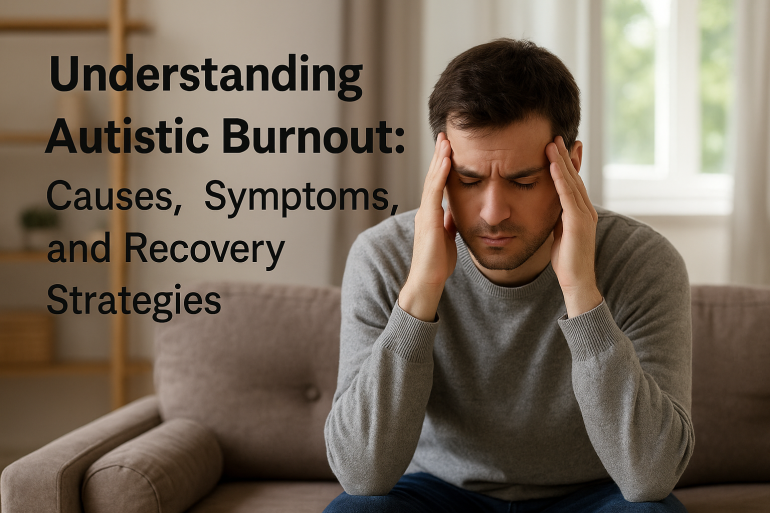What Is Autistic Burnout?
Autistic burnout is a state of intense physical, emotional, and mental exhaustion experienced by individuals on the autism spectrum. It arises from prolonged exposure to stressors, sensory overload, and the continuous effort to conform to neurotypical expectations. Unlike general burnout, autistic burnout deeply affects one’s ability to function, often leading to a loss of previously acquired skills and heightened sensitivity to stimuli.allstaraba.org+4neurosparkhealth.com+4Verywell Mind+4autism.org.uk
Common Symptoms of Autistic Burnout
Recognizing the signs of autistic burnout is crucial for timely intervention. Common symptoms include:
Extreme Fatigue: Persistent tiredness that doesn’t improve with rest.
Loss of Skills: Difficulty performing tasks that were once manageable.
Increased Sensory Sensitivity: Heightened reactions to light, sound, or touch.
Emotional Dysregulation: Frequent mood swings, irritability, or emotional numbness.
Social Withdrawal: Avoidance of social interactions and a preference for solitude.
Executive Dysfunction: Challenges with planning, organizing, or initiating tasks.neurosparkhealth.com
Primary Causes of Autistic Burnout
Understanding the root causes can aid in prevention and recovery:
1. Chronic Masking
Many autistic individuals engage in masking—suppressing natural behaviors to fit societal norms. This constant self-monitoring is mentally exhausting and can lead to burnout.Autism Awareness Australia+2Verywell Health+2neurosparkhealth.com+2Psych Central+1neurosparkhealth.com+1
2. Sensory Overload
Environments with excessive noise, bright lights, or strong smells can overwhelm the senses, leading to heightened stress and fatigue.heyasd.com+2neurosparkhealth.com+2allstaraba.org+2
3. Social Expectations
Navigating social norms and expectations can be draining, especially when there’s pressure to conform without adequate support.
4. Life Transitions
Major changes, such as starting a new job or moving, can disrupt routines and increase stress levels.The Everyday Autistic
5. Lack of Support
Insufficient understanding and accommodations from workplaces, schools, or families can exacerbate feelings of isolation and overwhelm.
7 Effective Strategies for Recovery
Recovery from autistic burnout requires a multifaceted approach:
1. Prioritize Rest
Allow yourself ample time to rest without guilt. Recognize that rest is essential for recovery.The Everyday Autistic+1Seasons of Growth Counseling+1
2. Create a Sensory-Friendly Environment
Modify your surroundings to reduce sensory input—use noise-canceling headphones, dim lighting, or weighted blankets as needed.neurosparkhealth.com+1Neurodivergent Insights+1
3. Establish Routines
Consistent daily routines can provide a sense of stability and predictability, reducing anxiety.
4. Engage in Special Interests
Dedicate time to activities or topics you’re passionate about. These can serve as therapeutic outlets.
5. Seek Support
Connect with supportive individuals, whether friends, family, or support groups, who understand and validate your experiences.allstaraba.org
6. Set Boundaries
Learn to say no to activities or commitments that may lead to overstimulation or stress.neurosparkhealth.com+1The Everyday Autistic+1
7. Consult Professionals
Work with therapists or counselors familiar with autism to develop personalized coping strategies.
FAQs
Q1: How long does autistic burnout last?
The duration varies; it can last from a few days to several months, depending on individual circumstances and support systems.
Q2: Can non-autistic individuals experience similar burnout?
While anyone can experience burnout, autistic burnout has unique features tied to the autistic experience, such as sensory sensitivities and masking.
Q3: Is autistic burnout recognized in medical literature?
While not officially listed in diagnostic manuals, autistic burnout is increasingly acknowledged by professionals and researchers.
Q4: How can employers support autistic employees to prevent burnout?
Employers can offer flexible work arrangements, provide sensory-friendly workspaces, and foster an inclusive environment.neurosparkhealth.com+1Seasons of Growth Counseling+1
Q5: Are there specific therapies recommended for autistic burnout?
Therapies focusing on stress management, sensory integration, and cognitive-behavioral approaches can be beneficial.
Q6: Can children experience autistic burnout?
Yes, children can experience burnout, especially during transitions or when facing overwhelming demands without adequate support.
Conclusion
Autistic burnout is a profound challenge that affects many on the spectrum. Recognizing its signs and understanding its causes are the first steps toward recovery. By implementing tailored strategies and seeking supportive environments, individuals can navigate burnout and move toward a balanced, fulfilling life.

